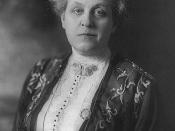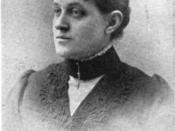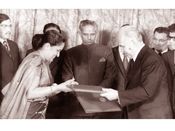Women's Liberation Movement (1960's)
Imagine yourself as a woman in the 1960s. They are denied basic rights, trapped in the home for life, and discriminated against in the workplace. Then the 1960s came along with it, the thought that women could have a say in their government, that they could perhaps leave home without feeling guilty about leaving their children alone, and that they could receive a job and earn wages just like men.
The women's liberation movement of the 1960s helped all these changes to come about, through its record number of policies and radical ways. Most women feminists were radicals. They formed groups, which researched to find the root of the problem and put and end to the barriers of segregation and discrimination based on sex. Women feminists were committed to the study the situation of women, instead of just taking action. In this movement women would have to see the fight of women as their own, not as something to help ?other women? and that they would have to see the truth about their own lives before they would fight in a radical way for anyone.
Women were denied basic rights in most aspects of society from political rights to reproductive rights; women in the U.S. fought vigorously for equality. Women fought for their right not to symbolize ?beauty objects? or ?sex objects.? In 1968, 100 women protested the Miss America Beauty Pageant. They were protesting because the pageant promoted ?physical attractiveness and charm as the primary measures of a women?s worth.? Since the media displayed beauty as the only way for happiness, the idea that women?s only importance was for their bodies became more widespread. With the Miss America protest and the Freedom Trash can protest; women claimed national attention towards their struggle. Also with the 1960s Civil Rights movement that was going on, it seemed just right for women to speak out.
Women also fought for abortion and reproductive rights. Women could only receive a prescription for birth control if she was married or a bride-to-be with a set date and having announced it. So girls who did not rush into marriage saw no reason why they should not have a sex life of their own during their early adult years. This question has always been up for debate. If the pills are wanted then they should be available, primarily by girls who intend to use them. However once a boy and a girl enter into an engagement there is always a chance they will go to bed together, with or with out the pill. The fact is that a good proportion of people, girls no less then boys, see nothing shameful or immoral about premarital sex.
One woman stated that, ?Abortion and preventative birth control methods are denied us unless we are of a certain age or married or perhaps they are denied us completely. Hospital committees decide whether or not we can have our tubes tied, unless our uterus has ?done its duty,? were often denied. We give birth in hospitals, run for the convenience of the staff, we?re drugged, strapped, cut, ignored, probed, shaved ? all in the name of ?superior care.?
In responds to the 1960s abortion effort, women established and underground abortion hospital called ?Jane? in Chicago. Most women who went to ?Jane? were middle class and white. Those who used the service ranged from housewives to students to poor women. After ?Jane? many other secret clinics launched up everywhere. Most likely the largest achievement for women regarding abortion rights came when the food and drug administration approved birth control pills.
Also women in the 1960s were stereotyped to only be capable of being a housewife and a child bearer. The typical American family consists of father, mother and child. Most women were hesitant about leaving their children alone. Although by the 1960s, more women started to get over this feeling of guilt and left the house more often to attend women?s meetings or clubs.
Society played a huge role on the way women were believed to be. Society believed that if a woman were to become pregnant, she would stay in the home, caring for her children, because that?s where she belonged. The women?s movement worked hard to put and end to this. A woman in a family relationship must be allowed to maintain her integrity as an individual. Children must have fathers as well as mothers. Responsibilities must be shared.
A major area in which the 1960s made many significant changes for women was in the workplace, In the 1960s there were no women bus drivers, welders, firefighters, news anchors, CEOS or Supreme Court Justices. Although when the economy began to expand, women began working for a second family income earning 40% less then men. . At this time only three women held their countries' highest elective offices by 1970. Sirimavo Bandaranaike was prime minister of Ceylon from 1960 to 1965 and from 1970 to 1977. Indira Gandhi was prime minister of India from 1966 to 1977 and from 1980 until her assassination in 1984. Carrie Chapman Catt estimated that:
To get the word "male" out of the Constitution cost the women of this country 52 years of pauseless campaign...During that time they were forced to conduct 56 campaigns of referenda to male voters, 480 campaigns to get legislatures to submit suffrage amendments to voters, 47 campaigns to get state constitutional conventions to write woman suffrage into state constitutions, 277 campaigns to get state party conventions to include woman suffrage planks, 30 campaigns to get presidential party conventions to adopt woman suffrage planks in party platforms and 19 campaigns with 19 successive Congresses.
During the early stages of the 1960s many changes were made to help women. These included the President?s commission on the Status of women chaired by Eleanor Roosevelt. This commission was eventually created in every state, each with a similar message, it was established to improve the quality of life for women. It is the Commission's pledge to encourage and inspire women to become leaders, problem solvers, and innovators making meaningful contributions to American society. Also the Equal pay act was created. It states, The EPA, which is part of the Fair Labor Standards Act of 1938, as amended (FLSA), and which is administered and enforced by the EEOC, prohibits sex-based wage discrimination between men and women in the same establishment who are performing under similar working conditions.
Another major achievement for women in regards to the work place was in 1964, when ?Title VII if the Civil Rights Act? banned employment discrimination by private employers, employment agencies and unions based on race, sex, and other grounds. Most of the 1960s has made positive changes for women in regards to the work place.
In conclusion, the 1960s really did make significant changes for women in regards to basic rights, domestic issues and workplace opportunities. However these changes took long to accomplish, because women were thought to be feminist militants if they wanted any type of change in society, which scared off many women. Basically women wanted equality. Women did not want to become men, but to have the same rights as men, to live the fullest of their capacities. The 1960s was a breakthrough for women.





